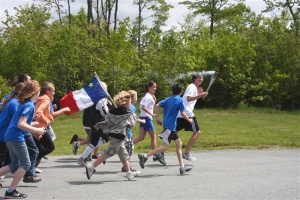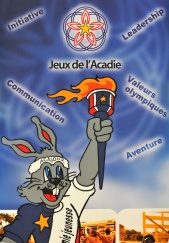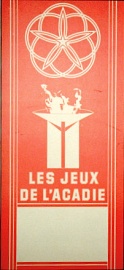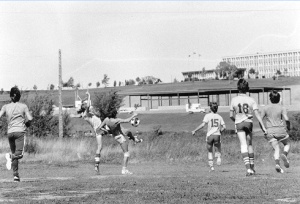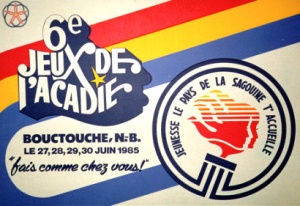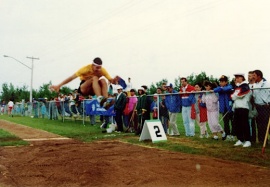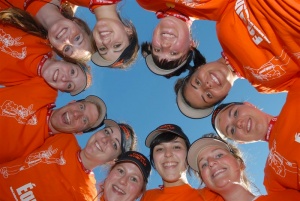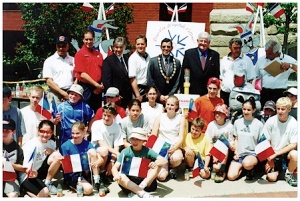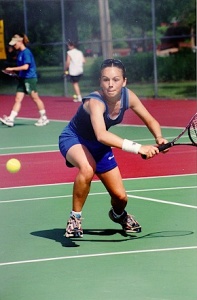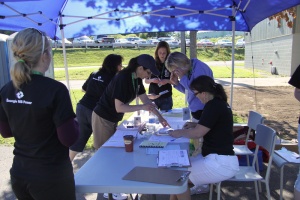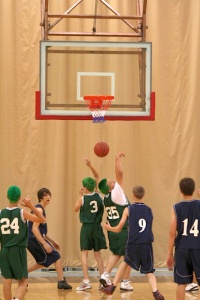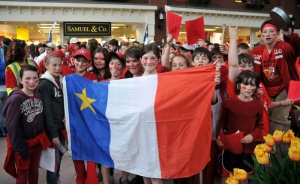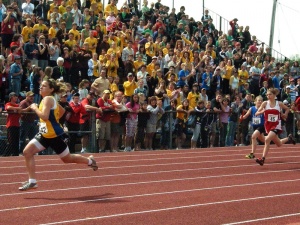The Acadian Games and the Growth and Development of the Acadian Community
par Allain, Greg
The year 1979 was a significant one in Acadia: not only did the nation celebrate the 375th anniversary of its founding, but the famous Tintamarre – held on August 15th – was born and permanently established. In addition to that, two important social networks were created: the Conseil économique acadien – which will later become the Conseil économique du Nouveau-Brunswick – and the Jeux de l'Acadie. As Daniel O’Carroll wrote in 1993, these represent “the most popular annual event and one of the greatest achievements of modern Acadia.” Indeed, the Jeux represent a wonderful opportunity for Acadians of all ages to learn and excel. The Jeux were a major factor in the development of a modern Acadia full of talents and achievements.
Article disponible en français : Jeux de l’Acadie et développement de la communauté acadienne
A Leading Role for Contemporary Acadian Culture
Because they inspire the youth – on an athletic, cultural and identity-building level – because they are growing without interruption, and because of their significant positive effect on the organisational capacity and the community pride of the Acadian society, the Jeux de l’Acadie are a symbol of the vitality of today’s Acadian society. The Jeux are also a model organisation for French-speaking minorities throughout Canada.
The Origins, How the Games were Started
The Jeux de l’Acadie were created in 1979. In the wake of the major reforms of the Robichaud Government in the 1960s, the 1970s saw the rise of a veritable Acadian renaissance in the fields of the arts, culture and economy as well as the creation of the first social organizations (NOTE 1). The conditions that resulted in the development of the Jeux de l’Acadie were largely created by a historic event: in order to celebrate the 375th anniversary of the founding of Acadia, a desire to organize a major event was widely expressed. In 1978, a keynote report on “Sports in the French-speaking communities of New-Brunswick” was published by the Université de Moncton’s Physical Education Department’s Institut de Leadership. The report was the focus of lively discussions during two seminars and regional consultations throughout the province. Following this debate, two conclusions were reached. On the one hand, regional sports facilities had to be established and provincial facilities had to be made more accessible to French-speakers. On the other hand, it was recommended that the Jeux de l’Acadie be modeled on the Jeux du Québec (founded in 1970). When the time came to choose an event to celebrate the 375th anniversary of the founding of Acadia, it was decided that the Jeux de l’Acadie (NOTE 2) would be held for the first time.
The Early Days, Organization and Popularity of the Games
The first Games were held at the Université de Moncton, the only place that had adequate sport facilities at the time. Young students (from ages 12 to 15) were the focus of the event, as it was deemed that this age group was largely neglected in most of the schools’ sport programmes, particularly because they did not have access to interscholastic competitions. The first Games were met with resounding success: 327 youths participated in six different athletic disciplines (NOTE 3), accompanied by sixty or so coaches and delegation leaders. After this initial resounding success, it was decided that the Games would become an annual event. Then, in the following year, Acadian youths from Prince Edward Island and Nova Scotia were also included, thereby making the Games one of the only two organizations to bring Acadians from the three Maritime Provinces together (NOTE 4).
The activity was then institutionalised and solid organizational foundations were set in place at this early stage of the project. As early as 1981, the Société des Jeux de l’Acadie was already incorporated and a permanent office was opened in Petit-Rocher in North-Eastern New Brunswick. Eight years later, the Académie Jeunesse (a leadership training program) was founded. Sometime later, in 1990, the Fondation des Jeux de l’Acadie was established to ensure a continuity of funding for the event.
Since 1982 (the 1981 Games having been cancelled due to the New Brunswick school teachers’ work-to-rule protest), the Games have two competition phases: regional trials (in which youths from each region compete to determine the best team in each sport) take place first to determine which teams will form the region’s official delegation. Following regional trials are the finals, which involves a gathering of all the regional delegations. This usually takes place in a town which has been selected a year in advance. Sometimes it is also held in a township or agglomeration of small neighbouring villages which have been chosen to host the finals. Furthermore, although the first two finals were held in Moncton, it was decided that from 1982 on the final event would be hosted in a different region every year, each taking its turn. As of October 2010, 13 of the 31 finals were held in different towns across North-eastern New Brunswick, 10 in the Southeast, as well as two events in St. John and one in Fredericton (towns in the South-western quarter of the province). Prince Edward Island has been host to the games twice and Nova Scotia once.
Youth participation statistics from the Games demonstrate the just how successful the event has been. The number of participants increased rapidly during the first editions of the Games (during the mid 1980s) and each year between 3000 and 4000 young athletes take part in the regional competitions, while around 1000 of them compete in the finals. Following the 31st finals held in June 2010, it was estimated that approximately 30,000 athletes had proven their mettle in the various finals since the Jeux were first held in 1979. Furthermore, more than 100,000 youths have participated in the various regional competitions. These are impressive figures considering the small number of French-Speakers in Eastern Canada (a little more than 275,000 according to the 2006 census) (NOTE 5).
Economic, Social and Cultural Benefits
Is it possible to fully measure the benefits of the Games? There are various indications on several levels: first, the host community usually acquires new or improved sports facilities, whether an entirely new athletic track and field facility is built, or the existing facilities improved (facilities generally built on school grounds). Once the event has come to an end, the facilities remain available for the school and the community (NOTE 6).
There are also economic benefits for the community in which the finals take place. Regular surveys are carried out to determine whether an increase in the event’s level of importance has occurred. In 1986, during the 7th finals in Lamèque, local economic benefits approached $640,000. In 1992, the finals produced economic benefits for the community of Grand Falls of a least a million dollars. By the 2002 Games in Dieppe, it had increased to $1.6 million and continued to rise June 2005, with $2 million in local economic activity that benefited the community of Beresford (NOTE 7). But the most significant achievement of the Games is that it has offered thousands of young folks throughout Acadia an opportunity to gather and participate in a major sporting event in their very own language! This in total conformity with the original vision that drove the founders of the Games: “Through encouraging athletic participation, it becomes possible to contribute to the development of a strong, united, and flourishing Atlantic French-speaking Acadian youth, proud of its Acadian [French] language and culture (NOTE 8)”.
The Games purpose is twofold: offering a forum for athletic competitions as well as a cultural venue to showcase and encourage the development of the French language and culture. The closing ceremony of the annual finals always includes a concert featuring Acadian artists and bands that is co-hosted by young Acadian animators and presenters from Radio-Canada. Public radio has been broadcasting the Games in Maritimes since 1979 and the event has been featured on national networks since 1991. Furthermore, the Games are entirely organized and held (both the regional competitions and the finals) entirely in French.
When the finals of the Games are hosted by a city in which French-speakers are a small minority and must constantly struggle for recognition by English-speakers, the event is beneficial for the Acadian community. It offers them increased visibility and contributes to raiding awareness among the English-speaking majority who learn a greater appreciation of French-speaking culture. The event is also a source of considerable pride among the French-speaking minority as they once again successfully rise to substantial challenge of organizing such an event. The considerable impact of the event was clearly visible during the 17th finals held in St. John in 1996, and once again in 2010, as well as in Fredericton during the 21st finals held in 2000 (NOTE 9).
Pride and Community Engagement
The young people who participate in the Jeux de l’Acadie take great pride in their association with the event. Various public figures have openly shared their pride in having taken part in the competitions of this great annual event. Moreover, this cultural pride continues to increase, as former members of the Jeux de l'Acadie have gone on to participate in the Francophone Games, the Canada Games and even in the Olympics (NOTE 10). If one thing is certain, it is that one of the key goals of the Games seems to have been achieved: that of improving the athletic skills of young Acadians and contributing to the ongoing development of athletics in French-speaking Acadia. In 1987, a survey of 132 French-speaking physical education teachers in the Maritimes revealed that 84% had observed increased levels of athletic skill among the participants of the Games.
Athletes are proud of their involvement. It is a feeling obviously shared by parents, families, and friends as well as by the communities involved, for both host and visiting participants alike. The preparations for the Games (which take a year or more) and the Games themselves, generate quite a lot of excitement in the communities that host the regional competitions and even more so in those which host the finals. For villages and small towns the arrival of more than a thousand athletes coming for the finals, along with their parents, families, friends, journalists, sports fans and the 1500 volunteers or so in charge of the organisation, create quite the stir! Furthermore, the finals usually allow locals to bring out the best the region has to offer. This is exactly what happened with Tracadie and Sheila—historical rivals—that co-hosted the 1982 event. The 8th Games, held in Memramcook, brought the eight “villages” of the Memramcook Valley together to collaborate in hosting the event.
Of course, none of this would be possible without the help of thousands of volunteers who, each year, participate in organizing the event. A promotional video states: “We believe that, all in all, volunteers give more than 600,000 hours annually for the Jeux de l’Acadie. Volunteering has thus been the key to the success of the Jeux de l’Acadie since its beginnings in 1979” (NOTE 11).
What’s more, there are volunteers during the Games who contribute in a wide variety of fields: coaches who train young athletes during many months prior to the competitions; members of the organizing committees of the regional competitions and the finals; the individuals in charge of planning, communications and finances; as well as specialized teams of people responsible for logistics, transport, housing, food, etc. (NOTE 12).
Training up the Next Generation
Another significant benefit of the Games is how it fosters the development of leadership in two main ways. On the one hand, adult volunteers gain practical knowledge, as well as organizational and management skills. Such skills will be useful to them later on, whether it be in sports or even in other fields of activity. Many end up taking on regional leadership roles or head up delegations for other events, such as Canadian national or international athletic events (including the Olympics).
On the other hand, the development of leadership among the youth has also been a priority for the leading officials of the Games. In 1989, the Académie Jeunesse (a leadership training program for former Games participants, ageing from 15 to 20) was established. Every year, anywhere around 80 to 200 youths take part in the regional workshops. After the initial event, three delegates from each of the nine regions are invited to take part in the annual meeting, which lasts five days. Around 3,500 youths have participated in activity at the regional level and more than 600 at the provincial level.
The key objective for the Société des Jeux de l'Acadie is to train a new generation of leaders. But in so doing, the Académie Jeunesse also endeavours to develop leadership skills in among the French-speaking youth of the province. These newly developed skills enable them to take on further responsibilities in a wide variety of contexts—and that something that can only serve to benefit Acadian society.
These are some of the broader ramifications of the Games that have an impact throughout Acadia. The presence of Acadians in provincial athletic organisations has increased significantly (NOTE 13). As a matter of fact, several of the young athletes who have taken part in the Games, as well as those who have attended the Academy now hold leadership positions at various levels of Acadian society. And so, the overwhelming success of the Games has reinforced what sociologist Raymond Breton calls the institutional completeness Games in that it contributes to improving organizational capacity of Acadian society. These two key components are fundamental to increasing the visibility of minority societies and to strengthening the sociolinguistic vitality within their communities.
A Quebecker analyst writes: “The Jeux de l’Acadie are a key, instrumental element that enables Acadians to assert their cultural identity which offers their communities a chance to unmistakably increase their visibility. By increasing its visibility, a minority seeks to at least gain the recognition of the majority, if not its approval. It is basically asserting the right to exist and grow without interference (NOTE 14). For a minority, increasing visibility is, in and of itself, a sign of change. It proves that, as a society, it has been empowered to act.”
A Dynamic Initiative and Model for the Cultural Growth and Development of a Community
Today, after more than 30 years, the Jeux de l’Acadie have become a key event for Acadian youth, as well as for Acadian society as a whole. The event is one of Acadian society’s fastest growing socio-cultural networks. The organization has had no difficulty obtaining sponsorship and developing partnerships. As a result, the event is much less dependent on government grants than many other community organizations. Such a high level of self-financing bodes well for the future of the Games. Ultimately, a minority society lacking its own government and funding to ensure self regulation must rely much more on independent social and communal networks, This constitutes the lifeblood of the Acadian community’s continued vitality and ensures the ongoing structuration and organization of this minority society as a whole (NOTE 15). And it seems to be a winning formula, for the Jeux de l’Acadie have influenced other minority communities, inspiring the foundation of the Jeux Franco-Albertains in 1992, as well as the birth of the Jeux Franco-Ontariens two years later (NOTE 16)!
Greg Allain
Professor
Sociology department, Université de Moncton
Additional DocumentsSome documents require an additional plugin to be consulted
Images
-
 Affiche de la 4e édit
Affiche de la 4e édit
ion des Jeux de... -
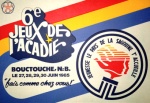 Affiche des 6e Jeux d
Affiche des 6e Jeux d
e l'Acadie à Bo... -
 Affiche des Jeux de l
Affiche des Jeux de l
'Acadie, où son... -
 Animation avec la mas
Animation avec la mas
cotte Acajoux a...
-
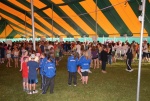 Animation sour la ten
Animation sour la ten
te, Jeux de l'A... -
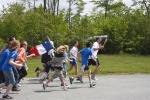 Arrivée de la flamme
Arrivée de la flamme
aux Jeux de l'A... -
 Bannière des premiers
Bannière des premiers
Jeux de l'Acad... -
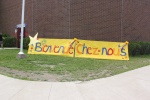 Bienvenue chez nous!
Bienvenue chez nous!
Bannière d'accu...
-
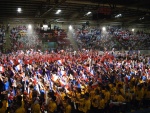 Cérémonie d'ouverture
Cérémonie d'ouverture
des Jeux à Hal... -
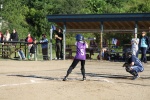 Compétition de baseba
Compétition de baseba
ll à la 31e fin... -
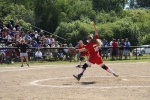 Compétition de baseba
Compétition de baseba
ll féminin à la... -
 Compétition de basket
Compétition de basket
ball masculin à...
-
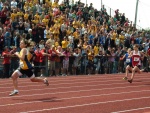 Compétition de course
Compétition de course
à pied aux Jeu... -
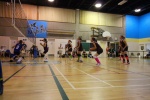 Compétition de handba
Compétition de handba
ll féminin, 31e... -
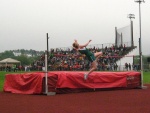 Compétition de saut e
Compétition de saut e
n hauteur aux J... -
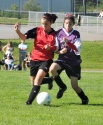 Compétition de soccer
Compétition de soccer
féminin à la 3...
-
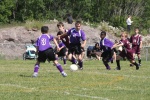 Compétition de soccer
Compétition de soccer
masculin à la ... -
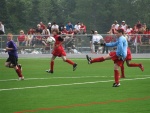 Compétition de soccer
Compétition de soccer
masculin aux J... -
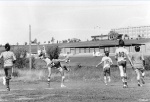 Compétition de soccer
Compétition de soccer
masculin aux p... -
 Compétition de tennis
Compétition de tennis
aux Jeux de Fr...
-
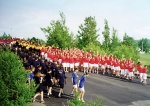 Défilé lors des Jeux
Défilé lors des Jeux
d'Edmunston (N.... -
 Drapeau acadien déplo
Drapeau acadien déplo
yé sur le champ... -
 Jeune compétitrice lo
Jeune compétitrice lo
rs de la 31e fi... -
 Jeunes participants d
Jeunes participants d
éployant fièrem...
-
 Jeunes participants e
Jeunes participants e
t membres de l'... -
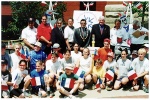 L'une des délégations
L'une des délégations
aux Jeux de Fr... -
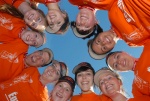 L'une des équipes jeu
L'une des équipes jeu
nesse à l'occas... -
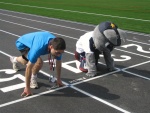 On simule le départ d
On simule le départ d
'une course! Je...
-
 Quelques bénévoles s'
Quelques bénévoles s'
affairant penda... -
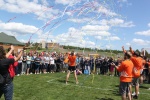 Rassemblement de quel
Rassemblement de quel
ques équipes, 3... -
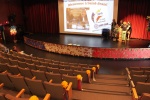 Salle de spectacle pr
Salle de spectacle pr
éparée pour l'o... -
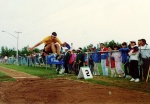 Saut en longueur aux
Saut en longueur aux
Jeux de Shippag...
Hyperliens
- Société des Jeux de l'Acadie
- Galerie de photos des Jeux de l'Acadie, site de l'Université de Moncton
Catégories
Notes
1. Chiasson 2003; Allain 2004; Allain 2005a.
2. Jean-Luc Bélanger, a government employee based in Campbellton, was the first to suggest the idea of the Jeux de l’Acadie in that context. He was behind the Jeux Régionaux du Restigouche. These had been held each summer since 1973 in the Restigouche regional county and were modeled on the Jeux de l'Est du Québec (Lamarre, 2000).
3. In 2010, Jeux de l’Acadie consisted of 10 athletic competitions: athletics, badminton, basketball, mini handball, soccer (men’s and women’s), softball, tennis, and volleyball (men’s and women’s). From 1985 on, a additional new sport was introduced almost every year (such as artistic gymnastics, synchronized swimming, mountain biking, beach volleyball, etc).
4. In 2008, after having been allowed to participate as a visiting delegation for several years, the delegation of French-speakers from Newfoundland and Labrador became the 9th permanent member of the Jeux de l’Acadie. Today the Games have brought Acadians from the four Atlantic provinces closer together. The additional eight delegations include the six regions of New Brunswick: Chaleur, Kent, Madawaska, Peninsula, Restigouche, Southeast, as well as the provinces of Nova Scotia and Prince Edward Island. Other delegations have been invited over the years, including France (four times) the United States (twice: neighbouring Maine and the town of Carencro in Louisiana), Western Canada, Northwest Territories, Orléans in Ontario, as well as Quebec and the Magdalen Islands.
5. Based on the criteria of first language (native speakers). According the 2006 Census of Canada, there were 235,205 French-speakers in New Brunswick, representing 32.7% of the province’s population. In Nova Scotia, there were 33,590 (3.7%) and 5,590 (4.2%) in Prince Edward Island. As for Newfoundland and Labrador, which recently joined the other official delegations (2008) there were 2,035 French-speakers (0.4% of the province’s population).
6. Due to space limitations, it was not possible to present all the original sources here. They can be found in our summary text (Allain, 2007).
8. Jeux de l'Acadie Website, accessed October 1st, 2010 at: www.jeuxdelacadie.org.
10. An example is runner Joël Bourgeois, who competed in the Olympics in Atlanta and Sydney; the volleyball player Brigitte Soucy, who was present in Atlanta; and the gymnast Lise Gautreau, who competed in Seoul, South Korea. In addition, due to the expertise of the Jeux de l’Acadie team, it was possible for them to contribute proactively to the organization of the first Francophone Games in Canada, held in Memramcook on August 1999, as well as to the International Francophone Games, held on January 2001, in the National Capital Region.
11. “In order to obtain the annual number of volunteer hours, many volunteer groups have to be taken into account. Among others, there are the 1,500 volunteers of the organizing committees for the finals, the 400 individuals working for the eight regional committees, the 1,600 members of the organising committees for the regional events, as well as those who sit on the standing committees and further individuals whose volunteer participation insures the success of the Société des Jeux de l'Acadie. Finally, there are also the volunteers involved in organizing and managing the regular day-to-day operations.” (Historique de la Société des Jeux de l'Acadie, s.d., pp. 6).
12. The promotional video for the Games highlights the importance of volunteering. The Jeux de l’Acadie involves 3,000 volunteers. They are people of all ages and from different professional backgrounds who work together in order to stand shoulder to shoulder with those young people who seek to seize their day and push themselves to fullest extent of their limits and their potential. The Games also involves those volunteers who, over many months, patiently help athletes with their training. These are volunteers who teach athletes the basic techniques that the various sports involve. They are ever encouraging the young athletes to be persistent and to ask more of themselves. The organization of the Jeux de l’Acadie also depends heavily on the thousands of volunteers who, each year, across the eight Acadian regions of the Maritimes, are responsible for planning and organizing the regional events. Additional volunteers work hard all year long to organize the finals of the Jeux de l’Acadie. The arrival of the flame in the event stadium announces the beginning of three days of competition and the crowning achievement of the labours of thousands of Acadians. An army of volunteers offer their expertise to make it possible to hold this local sporting, social and cultural event (Excerpt from the promotional video of the Jeux de l’Acadie).
13. This was one of the objectives of the creators of the Games. For example, before the founding of the Games, in 1975-1976, the provincial organization in charge of athletic events in New Brunswick (which at that time was comprised of 36 sports associations) did not include a single Acadian... In 2005, Acadians held 50% of the organisation’s seats, including that of president and vice-president! (Allain, 2007, pp. 128-129).
15. Gilbert and Lefebvre, 2008.
16. Although, an analyst (Dallaire, 2007) highlights the differences between the three different editions of the Games, those held in Alberta are of necessity of somewhat smaller scope, largely due to the demographic and socio-political context of the province. As for the Jeux de l’Ontario, as an athletic event, it is not as central to the Franco-Ontarian community as the Jeux de l’Acadie is to Acadians, particularly since it is only one of the six components of a large “youth festival”. Nonetheless, that portion is the most popular part of the event (Dallaire, 2007, pp.164).
Bibliographie
Allain, Greg, « Fragmentation ou vitalité? Regard sociologique sur l'Acadie actuelle et ses réseaux associatifs », dans Simon Langlois et Jocelyn Létourneau (dir.),Aspects de la nouvelle francophonie canadienne, Québec, Presses de l'Université Laval, 2004, p. 231-254.
Allain, Greg, « La “nouvelle capitale acadienne”? Les entrepreneurs acadiens et la croissance récente du Grand Moncton », Francophonies d'Amérique, no 19 (numéro spécial sur le 400e anniversaire de l'Acadie), printemps 2005, p. 19-43.
Allain, Greg, « Les conditions de la vitalité socioculturelle chez les minorités francophones en milieu urbain : deux cas en Acadie du Nouveau-Brunswick »,Francophonies d'Amérique, no 20, automne 2005, p. 133-146.
Allain, Greg, « Genèse, structure et bilan d'une manifestation sportive et identitaire pour la jeunesse acadienne : les Jeux de l'Acadie dans les provinces maritimes du Canada », dans Jean-Pierre Augustin et Christine Dallaire (dir.), Jeux, sports et francophonie : l'exemple du Canada, Pessac (France), Maison des sciences de l'homme d'Aquitaine, 2007, p. 95-137.
Chiasson, Herménégilde, « Moncton et la renaissance culturelle acadienne », Francophonies d'Amérique, no 16, automne 2003, p. 79-84.
Dallaire, Christine, « Les festivals sportifs et la reproduction des communautés minoritaires : une analyse comparative des Jeux francophones au Canada », dans Jean-Pierre Augustin et Christine Dallaire (dir.), Jeux, sports et francophonie : l'exemple du Canada, Pessac (France), Maison des sciences de l'homme d'Aquitaine, 2007, p. 139-172.
Gilbert, Anne, et Marie Lefebvre, « Un espace sous tension : nouvel enjeu de la vitalité communautaire de la francophonie canadienne », dans Joseph Yvon Thériault, Anne Gilbert et Linda Cardinal (dir.), L'espace francophone en milieu minoritaire au Canada : nouveaux enjeux, nouvelles mobilisations, Montréal, Fides, 2008, p. 27-72.
Lamarre, Jules, « Les Jeux de l'Acadie et le Québec », dans Fernand Harvey et Gérard Beaulieu (dir.), Les relations entre le Québec et l'Acadie, 1880-2000 : de la tradition à la modernité, Québec, Éditions de l'IQRC; Moncton, Éditions d'Acadie, 2000, p. 277-295.
O'Carroll, Daniel, « Les activités sportives en Acadie », dans Jean Daigle (dir.), L'Acadie des Maritimes : études thématiques des débuts à nos jours, Moncton, Chaire d'études acadiennes, Université de Moncton, 1993, p. 587-600.
Thériault, Joseph Yvon, « Le moment Robichaud et la politique en Acadie », dans L'ère Louis J. Robichaud, 1960-1970 : actes du colloque (Bouctouche, 8-9 septembre 1999), Moncton, Institut canadien de recherche sur le développement régional, 2001, p. 39-54.
Young, Robert A., « Le programme Chances égales pour tous : une vue d'ensemble », dans L'ère Louis J. Robichaud, 1960-1970 : actes du colloque (Bouctouche, 8-9 septembre 1999), Moncton, Institut canadien de recherche sur le développement régional, 2001, p. 23-37.
Document audio-visuel
Jeux de l'Acadie : plus que des Jeux, documentaire de Chris LeBlanc, Tracadie-Sheila (N.-B.), Cojak Productions, 2008.

